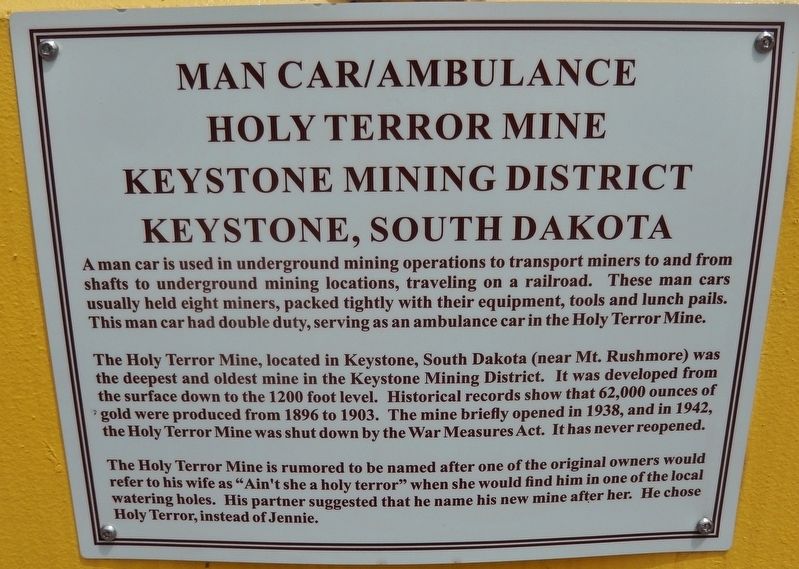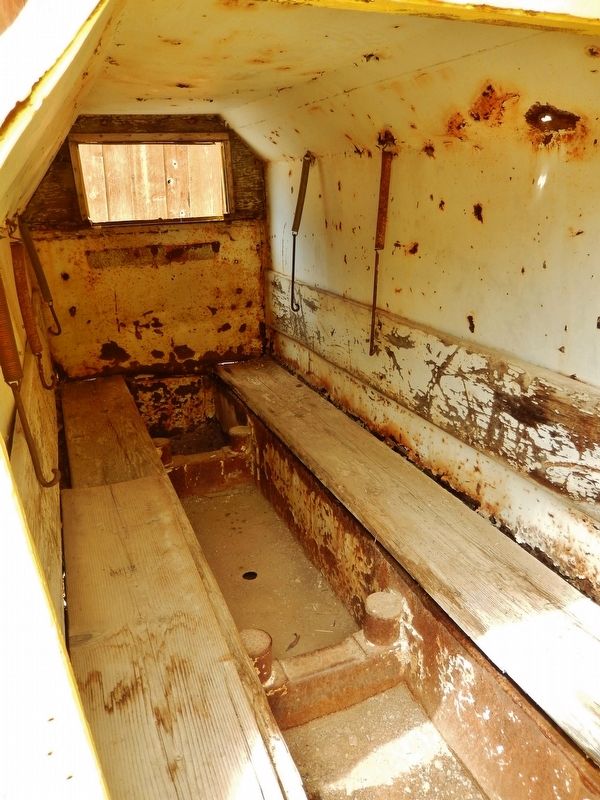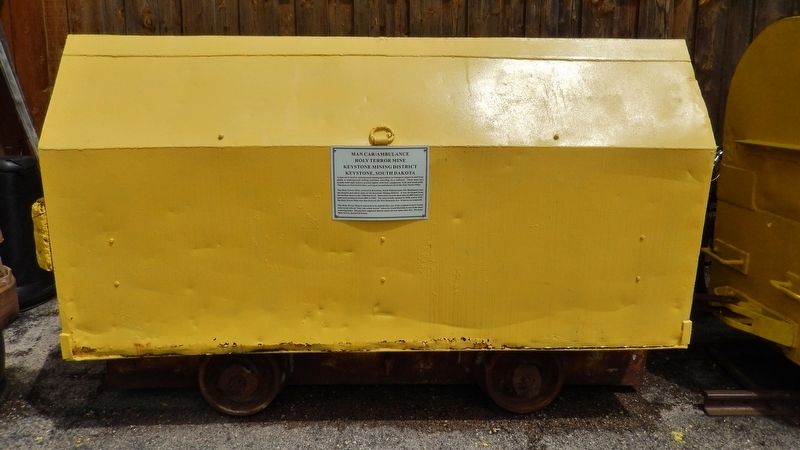Lead in Lawrence County, South Dakota — The American Midwest (Upper Plains)
Man Car / Ambulance
Holy Terror Mine, Keystone Mining District
— Keystone, South Dakota —
The Holy Terror Mine, located in Keystone, South Dakota (near Mt. Rushmore) was the deepest and oldest mine in the Keystone Mining District. It was developed from the surface down to the 1200 foot level. Historical records show that 62,000 ounces of gold were produced from 1896 to 1903. The mine briefly opened in 1938, and in 1942, the Holy Terror Mine was shut down by the War Measures Act. It has never reopened.
The Holy Terror Mine is rumored to be named after one of the original owners would refer to his wife as "Ain't she a holy terror" when she would find him in one of the local watering holes. His partner suggested that he name his new mine after her. He chose Holy Terror, instead of Jennie.
Erected by Black Hills Mining Museum.
Topics. This historical marker is listed in these topic lists: Industry & Commerce • Railroads & Streetcars.
Location. 44° 21.109′ N, 103° 46.036′ W. Marker is in Lead, South Dakota, in Lawrence County. Marker is on West Main Street (CanAm Highway) (U.S. 85) east of Stone Street, on the right when traveling east. Marker and subject rail car are located in the Black Hills Mining Museum parking lot, on the south side of West Main Street. Touch for map. Marker is at or near this postal address: 323 West Main Street, Lead SD 57754, United States of America. Touch for directions.
Other nearby markers. At least 8 other markers are within walking distance of this marker. Man Car (here, next to this marker); Battery Locomotive (here, next to this marker); Ore Cars (here, next to this marker); Spargo Hoist & Sinking Bucket (a few steps from this marker); Compressed Air Locomotive #9 (a few steps from this marker); Overshot Mucker (a few steps from this marker); The Homestake Opera House & Recreation Building (within shouting distance of this marker); United States Post Office (within shouting distance of this marker). Touch for a list and map of all markers in Lead.
More about this marker. Marker is a metal plaque mounted directly on the subject rail car.
Also see . . . The Holy Terror Mine. By 1903, the Holy Terror Mine reached a depth of 1,200 feet. However, the mining company's early success was bogged down by underground water problems and litigation from fatal mine accidents and claim disputes. The mine ceased operation in 1903, and was allowed to fill with water. The Holy Terror had a brief revival from 1938 to 1942. Ore was mined in the neighboring Keystone Mine, brought to the surface through the Holy Terror shaft and processed at the Keystone mill. The story of the Holy Terror could see another revival in the future. A Canadian company in 2013 began drilling test holes to map the quality of the ore that remains in the Holy Terror vein. (Submitted on August 14, 2018, by Cosmos Mariner of Cape Canaveral, Florida.)
Credits. This page was last revised on August 15, 2018. It was originally submitted on August 12, 2018, by Cosmos Mariner of Cape Canaveral, Florida. This page has been viewed 153 times since then and 16 times this year. Photos: 1, 2, 3. submitted on August 14, 2018, by Cosmos Mariner of Cape Canaveral, Florida. • Andrew Ruppenstein was the editor who published this page.


